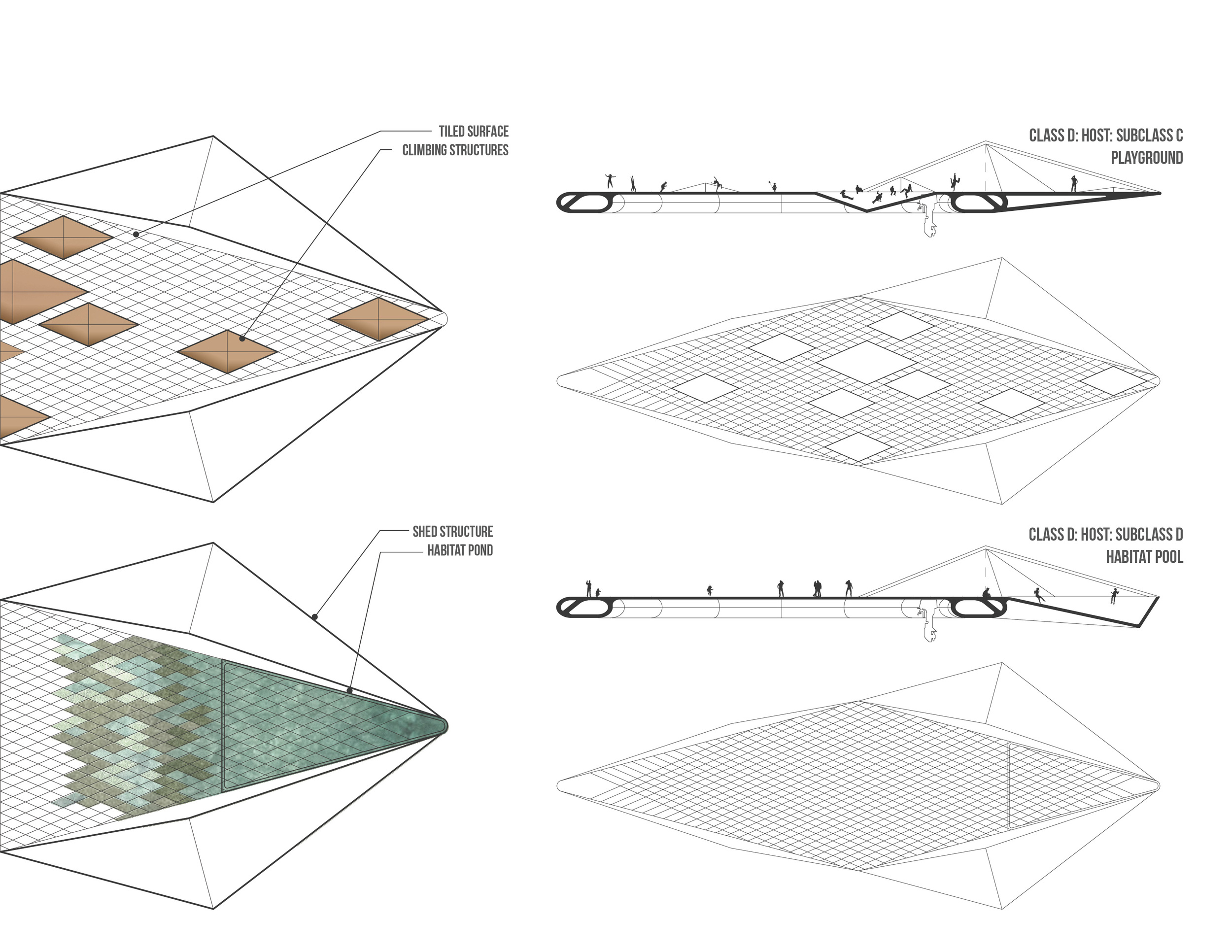CRUDE FRONTIERS
No territory in the United States exhibits a bigger tension between extraction and conservation on public lands than the North Slope of Alaska; Crude North investigates future scenarios of extraction on this territory. To understand what might happen next here, we can look to what has happened in the past: the population in Alaska has grown and shrunk in response to oil plays, in consistent boom-bust cycles. How might an expanded eco-tourism economy help to buffer the swings of the extraction economy, and how might hybridized installations along the Trans-Alaska highway and pipeline support both workers and tourists?
Today, settlements cluster around pipeline pumping stations and depots dating to the pipeline’s construction. Much of the route will need work as a result of shifting permafrost zones. This project imagines a Trans-Alaskan energy armature that in the near future might be expanded and rethought, offering new facilities for the extraction rush and the experience of nature.

















![The [Re]Active Layer](https://images.squarespace-cdn.com/content/v1/5435add3e4b00a9987e4bdca/1438559434440-E79LU5GG478QQYOYGY2W/image-asset.jpeg)































AQUEOUS INFRASTRUCTURES
Much of Florida is an environment whose image has been recast, and its ground transformed, from “uninhabitable” swamp into a tourist/retirement mecca. The entire Sunshine State is a region of attractions, theme parks and water-based recreation. A principal motivation of the studio, which will focus in and around Miami, is to provoke challenges to conventional approaches to waterfront design. It is a region that is one of the most vulnerable to climate change yet, despite the conflicting agendas of various interests groups over resource allocation for restoration, conservation, and development, they all tend to operate with similar presumptions about the stability or predictability of their particular model (whether habitat, markets, etc). As an alternative, students will be asked to develop projects that identify multiple scenarios/conditions under which their projects can perform based on environmental or economic fluctuations. Given the context of Miami, a primary question for the studio is: how can we take seriously the notion of “attraction” without confining the landscape to a nature reserve model or a theme park model, both of which are bounded in time and space? And secondly, as a means to think about how we employ technology in the making and control of landscapes, how can the notion of “liminal machines” facilitate this exploration (liminal being a state of transition or in-between; “machine” being an apparatus that performs some explicit function)?
-Karen M’Closkey
This project addresses these questions by focusing on Biscayne Bay in southern Florida, an estuary that connected the Everglades to the Atlantic Ocean until rapid development in the early to mid-twentieth century radically altered the relationship of this freshwater/saltwater exchange. The city of Miami sits on a limestone ridge at the threshold of these zones. The projects extents include the northern area of Biscayne Bay; however, proposals will focus off of the shore of the developing Brickell district. The site, which is an extension of downtown Miami near Miami Beach, offers the ideal location and conditions for considering the relationship between touristic and ecological understandings of place.




















INTERSTITIAL LANDSCAPES
Olympics and the Seville Expo in 1992, through to the global economic collapse of 2008, Spain experienced an unprecedented expansion of its urbanized territory. Between 2002 and 2008 alone, more than 4.4 million new residences were constructed across the country with current estimates of more than half of these continuing to remain unoccupied (McGovern 2008; Campbell 2011). Spain built more than 5,000km of new highway in the last two decades, leaving the country with the fourth longest highway system in the world behind only the continental networks of the U.S., China and Canada (Eurostat 2011; CIA World Factbook 2012). Of Spain’s 50 international airports, 15 of them qualify economically as ghost airports based on annual passenger numbers, with the privately financed Aeropuerto de Ciudad Real perhaps the most conspicuous with zero commercial flights currently scheduled despite an investment of 1.1 billion Euros (Grupo AENA 2011; Moran 2012). Spain has constructed more than 2,600km of high-speed rail track, ranking behind only China in terms of total length, with plans to have doubled this length by 2015 (Sheehan 2012; EuropaPress 2010). And Comunidad de Madrid alone built 65km of new metro between 1990 and 1999 and another 118km of new metro between 2000 and 2011, creating the eighth longest metro system in the world despite being only the 50th most populous metropolitan area (MetroMadrid 2012). This infrastructural investment was companioned by the construction of innumerable cultural and civic facilities throughout the country, including infamous white elephants like Peter Eisenman’s Galicia City of Culture and Santiago Calatrava’s City of Arts and Sciences in Valencia.
-Cristopher Marcinkoski
Despite the current media narrative regarding the exceptionality of the global real estate bubble of the first decade of the 21st century, these abridged urban landscapes are not a new phenomenon. Rather, episodes of failed speculative urbanization are a recurrent circumstance throughout history, taking place at a range of scales with varying degrees of long-term effect. Contemporary and antecedent examples abound, but the recent proliferation of these unfinished territories demonstrates an increasing reliance on urbanization as a preferred instrument of economic production in both established and emerging economies. While there is little question that these dormant settlements are a consequence of economic and political policy decisions made primarily outside of the traditional purview of design and planning, the premise of this investigation contends that the physical planning and design solutions that have companioned this speculative urbanization are equally complicit in the production of these failed landscapes.
This project used the current urbanistic situation in Spain as a laboratory within which to consider the vast and numerous landscapes of incomplete and unoccupied contemporary urban development, leisure amenities and mobility infrastructures that have proliferated globally over the last two decades in a range of diverse geographic, political and economic contexts.






















EDAPHIC ECOLOGIES
The City of Philadelphia’s leadership has pinpointed vacant land as a potential resource for augmenting its overburdened stormwater infrastructure. Inadequate stormwater infrastructure is one of the most prevalent problems facing post-industrial cities, like Philadelphia, today. Irrespective of whether stormwater and household-waste sewer systems are combined (CSS) or separate (SSS), the largest waterway pollution comes from wet-weather flow. The increasing relevance of “green infrastructure” today, which was merely a fringe concern two decades ago, is impressive and essential; however, the checklist of quantifiable criteria, lack of research or exploration, and segregation of the disciplines has led to a small number of default solutions for bio-technical stormwater features.
This project uses two separate but emerging trends in landscape, bio-synthetics and digital media, to explore customized ‘green infrastructure’ features in sites of vacancy. The site chosen for this investigation is an abandoned pier off the on the Delaware River just north of Penn’s Landing.












LIGHTXSOUNDXMOTION
LightxSoundxMotion (LSM) is experimentation in developing thickly operable and highly flexible spatial constructs that rely upon direct, qualitative and/or quantitative feedback with physical constructs.








DEPLOYABLE ECOLOGIES
Combined sewer systems have were, historically, a convenient solution for developing American cities. Our secondary and tertiary waterways were once considered undesirable bodies or water that produce disease and were primarily used for industrial transportation. In the recent decades we have appropriated our view on these resources and value these aquatic resources for the ecosystems that they support and their recreational potential.
Today these hydro infrastructures are a large burden on our fresh waterways systems. During rain events combined storm systems are inundated by the volume of rainwater and sewage that occupy the underground pipelines. When these events occur the combined water spill over the check dams within the sewer system and discharges out of combined sewer outfalls (CSO) into adjacent bodies of water.
In Philadelphia 164 active CSO’s discharge into the Deleware the the Schuchkill River’s. These discharges occur when as little as .2 inches of rainfall within one hour. In 2002 the City was fined millions of dollars for its poor water treatment practices and agreed to improve its water treatment system by 2020. Until the City updates its sewer infrastructure how can it deal with the frequent pollution discharges into its primary waterways?
This project is a strategy that provides a solution for mitigating the pollutions from the CSO’s while making the cause, effect and process visible at the source. Live data was taken from the Philadelphia Water Department’s public database and advanced computation techniques were used to model the outfall discharges and mitigation process.












DIGITAL ECOLOGIES
A series of sequential images were produced to illustrate the sedimentation accumulation process in shallow waters flowing from the mouth of Miami River south along the coast of Brickell.




FIBBONACCI TILING
This project was an inquiry into transforming complex geometry components into complex surfaces. Advanced computation techniques were used to explore the possibilities of using CAD to design, measure and construct, what was previously thought to be, unachievable geometries.





PAPER GEOMETRIES
Advanced Computation techniques were used to design and build parametric structures from sheets paper.


ORA OBSCURA
This film explores the potential of establishing the digital community within the bounds of geophysical place. In a future where open space is limited, Ora Obscura serves as a tool to create place and connect us to nature while also engaging with synthetic space simultaneously.

